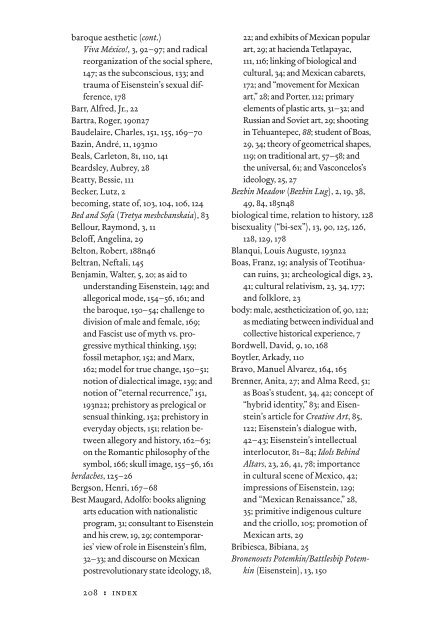In Excess: Sergei Eisentein's Mexico - Cineclub
In Excess: Sergei Eisentein's Mexico - Cineclub
In Excess: Sergei Eisentein's Mexico - Cineclub
You also want an ePaper? Increase the reach of your titles
YUMPU automatically turns print PDFs into web optimized ePapers that Google loves.
aroque aesthetic (cont.)<br />
Viva México!, 3, 92–97; and radical<br />
reorganization of the social sphere,<br />
147; as the subconscious, 133; and<br />
trauma of Eisenstein’s sexual difference,<br />
178<br />
Barr, Alfred, Jr., 22<br />
Bartra, Roger, 190n27<br />
Baudelaire, Charles, 151, 155, 169–70<br />
Bazin, André, 11, 193n10<br />
Beals, Carleton, 81, 110, 141<br />
Beardsley, Aubrey, 28<br />
Beatty, Bessie, 111<br />
Becker, Lutz, 2<br />
becoming, state of, 103, 104, 106, 124<br />
Bed and Sofa (Tretya meshchanskaia), 83<br />
Bellour, Raymond, 3, 11<br />
Beloff, Angelina, 29<br />
Belton, Robert, 188n46<br />
Beltran, Neftali, 145<br />
Benjamin, Walter, 5, 20; as aid to<br />
understanding Eisenstein, 149; and<br />
allegorical mode, 154–56, 161; and<br />
the baroque, 150–54; challenge to<br />
division of male and female, 169;<br />
and Fascist use of myth vs. progressive<br />
mythical thinking, 159;<br />
fossil metaphor, 152; and Marx,<br />
162; model for true change, 150–51;<br />
notion of dialectical image, 139; and<br />
notion of “eternal recurrence,” 151,<br />
193n22; prehistory as prelogical or<br />
sensual thinking, 152; prehistory in<br />
everyday objects, 151; relation between<br />
allegory and history, 162–63;<br />
on the Romantic philosophy of the<br />
symbol, 166; skull image, 155–56, 161<br />
berdaches, 125–26<br />
Bergson, Henri, 167–68<br />
Best Maugard, Adolfo: books aligning<br />
arts education with nationalistic<br />
program, 31; consultant to Eisenstein<br />
and his crew, 19, 29; contemporaries’<br />
view of role in Eisenstein’s fi lm,<br />
32–33; and discourse on Mexican<br />
postrevolutionary state ideology, 18,<br />
208 : index<br />
22; and exhibits of Mexican popular<br />
art, 29; at hacienda Tetlapayac,<br />
111, 116; linking of biological and<br />
cultural, 34; and Mexican cabarets,<br />
172; and “movement for Mexican<br />
art,” 28; and Porter, 112; primary<br />
elements of plastic arts, 31–32; and<br />
Russian and Soviet art, 29; shooting<br />
in Tehuantepec, 88; student of Boas,<br />
29, 34; theory of geometrical shapes,<br />
119; on traditional art, 57–58; and<br />
the universal, 61; and Vasconcelos’s<br />
ideology, 25, 27<br />
Bezbin Meadow (Bezbin Lug), 2, 19, 38,<br />
49, 84, 185n48<br />
biological time, relation to history, 128<br />
bisexuality (“bi-sex”), 13, 90, 125, 126,<br />
128, 129, 178<br />
Blanqui, Louis Auguste, 193n22<br />
Boas, Franz, 19; analysis of Teotihuacan<br />
ruins, 31; archeological digs, 23,<br />
41; cultural relativism, 23, 34, 177;<br />
and folklore, 23<br />
body: male, aestheticization of, 90, 122;<br />
as mediating between individual and<br />
collective historical experience, 7<br />
Bordwell, David, 9, 10, 168<br />
Boytler, Arkady, 110<br />
Bravo, Manuel Alvarez, 164, 165<br />
Brenner, Anita, 27; and Alma Reed, 51;<br />
as Boas’s student, 34, 42; concept of<br />
“hybrid identity,” 83; and Eisenstein’s<br />
article for Creative Art, 85,<br />
122; Eisenstein’s dialogue with,<br />
42–43; Eisenstein’s intellectual<br />
interlocutor, 81–84; Idols Behind<br />
Altars, 23, 26, 41, 78; importance<br />
in cultural scene of <strong>Mexico</strong>, 42;<br />
impressions of Eisenstein, 129;<br />
and “Mexican Renaissance,” 28,<br />
35; primitive indigenous culture<br />
and the criollo, 105; promotion of<br />
Mexican arts, 29<br />
Bribiesca, Bibiana, 25<br />
Bronenosets Potemkin/Battleship Potemkin<br />
(Eisenstein), 13, 150


